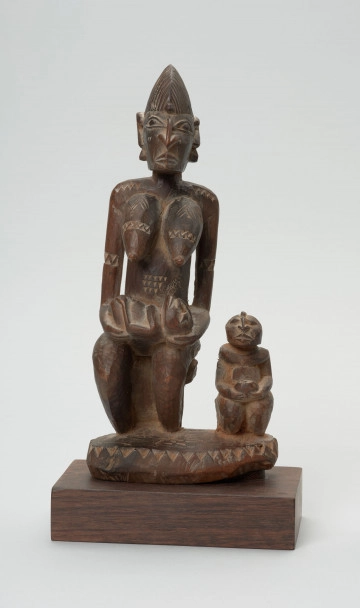
Figure - primogenitor
około 1970
National Museum in Szczecin
Part of the collection: Collection of Dogonian art
Dogon art abounds in depictions of a woman and child. They symbolically refer to maternal love and female fertility, which are highly valued in Africa. The women's ability to bear children is one of the most critical issues for the Dogon and all traditional African communities. The future of the family and the whole community depends on the fertility of women. Procreation, the appearance of successive generations, is a bond between the souls of the ancestors and their descendants. Although the Dogon admit that the fertility of a wife depends on the quality of the emotional relationship existing between the spouses, that is, on their mutual contact, the way they relate to each other, the words they exchange, they always blame the woman for the lack of offspring. Infertility is a big problem for a woman. Such a Dogon woman is treated as a person of no value, and her husband may send her away to her parents. In the Dogon country, there is polygyny, and one man can have more than one wife. So often, when a husband cannot wait to have children and does not want to send his wife away, he decides to take another. However, childlessness is not the only problem facing Dogon marriages. A tremendous pain for parents is also the high mortality rate of children, tiny ones. The Dogon want to have adult children because they know that they can count on their help in their old age. Although they rejoice at the birth of each child, they feel greater joy at the birth of a boy because a son stays with his parents, while a daughter, when she gets married, leaves the family homestead and moves to her husband's family.
Ewa Prądzyńska
Author / creator
Dimensions
cały obiekt: height: 49 cm, width: 14,6 cm
Object type
figure
Creation time / dating
Creation / finding place
Identification number
Location / status

unknown
około 1970
National Museum in Szczecin

unknown
między 1951 — 2000
National Museum in Szczecin

unknown
między 1951 — 2000
National Museum in Szczecin
DISCOVER this TOPIC
National Museum in Szczecin
DISCOVER this PATH
Educational path
0/500

We use cookies to make it easier for you to use our website and for statistical purposes. You can manage cookies by changing the settings of your web browser. More information in the Privacy Policy.
We use cookies to make it easier for you to use our website and for statistical purposes. You can manage cookies by changing the settings of your web browser. More information in the Privacy Policy.
Manage cookies:
This type of cookies is necessary for the website to function. You can change your browser settings to block them, but then the website will not work properly.
WYMAGANE
They are used to measure user engagement and generate statistics about the website to better understand how it is used. If you block this type of cookies, we will not be able to collect information about the use of the website and we will not be able to monitor its performance.